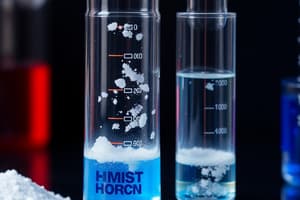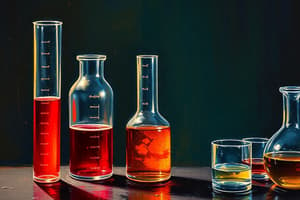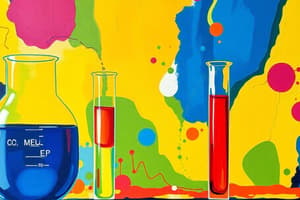Podcast
Questions and Answers
A solution turns litmus paper blue and phenolphthalein pink. What type of solution is it most likely to be?
A solution turns litmus paper blue and phenolphthalein pink. What type of solution is it most likely to be?
- A weak acid.
- A strong acid.
- A strong alkali. (correct)
- A weak alkali.
Which of the following statements accurately describes the behavior of weak acids in aqueous solutions?
Which of the following statements accurately describes the behavior of weak acids in aqueous solutions?
- They fully ionize, producing a high concentration of $H^+$ ions.
- They do not ionize at all.
- They fully ionize, but only at high temperatures.
- They partially ionize, resulting in a low concentration of $H^+$ ions. (correct)
If a solution has a high concentration of $OH^-$ ions, which of the following is most likely true?
If a solution has a high concentration of $OH^-$ ions, which of the following is most likely true?
- It is a strong acid.
- It is a weak acid.
- It is neutral.
- It is a strong alkali. (correct)
Which of the following metals would not produce hydrogen gas when reacted with hydrochloric acid ($HCl$)?
Which of the following metals would not produce hydrogen gas when reacted with hydrochloric acid ($HCl$)?
Which of the following reactions represents the behavior of a strong acid in water?
Which of the following reactions represents the behavior of a strong acid in water?
Which of the following is the correct ionic equation for the reaction between a carbonate and an acid?
Which of the following is the correct ionic equation for the reaction between a carbonate and an acid?
Which indicator would be most suitable for detecting the equivalence point in a titration of a strong acid with a weak alkali?
Which indicator would be most suitable for detecting the equivalence point in a titration of a strong acid with a weak alkali?
A solution of ethanoic acid ($CH_3COOH$) is tested with a universal indicator and shows a pH of 4. What does this indicate about the ethanoic acid?
A solution of ethanoic acid ($CH_3COOH$) is tested with a universal indicator and shows a pH of 4. What does this indicate about the ethanoic acid?
Sulfur trioxide ($SO_3$) reacts with water to form sulfuric acid ($H_2SO_4$). What is the classification of sulfur trioxide in this reaction?
Sulfur trioxide ($SO_3$) reacts with water to form sulfuric acid ($H_2SO_4$). What is the classification of sulfur trioxide in this reaction?
What is the expected product when any base reacts with an acid?
What is the expected product when any base reacts with an acid?
A solution of hydrochloric acid ($HCl$) is prepared such that one mole of $HCl$ yields one mole of $H^+$ ions in solution. What is the basicity of hydrochloric acid?
A solution of hydrochloric acid ($HCl$) is prepared such that one mole of $HCl$ yields one mole of $H^+$ ions in solution. What is the basicity of hydrochloric acid?
Which of the following reactions would not produce hydrogen gas?
Which of the following reactions would not produce hydrogen gas?
Which of the following solutions would have the highest concentration of $H^+$ ions?
Which of the following solutions would have the highest concentration of $H^+$ ions?
How does sodium hydrogencarbonate ($NaHCO_3$) function in antacids?
How does sodium hydrogencarbonate ($NaHCO_3$) function in antacids?
Which of the following acids can form both normal salts and acid salts?
Which of the following acids can form both normal salts and acid salts?
Tartaric acid is combined with sodium hydrogencarbonate in baking powder. What is the primary role of tartaric acid in this context?
Tartaric acid is combined with sodium hydrogencarbonate in baking powder. What is the primary role of tartaric acid in this context?
Which of the following is the most accurate representation of how acids form hydroxonium ions in an aqueous solution?
Which of the following is the most accurate representation of how acids form hydroxonium ions in an aqueous solution?
In the reaction $Zn(s) + 2HCl(aq)
ightarrow ZnCl_2(aq) + H_2(g)$, which definition of an acid is being demonstrated?
In the reaction $Zn(s) + 2HCl(aq) ightarrow ZnCl_2(aq) + H_2(g)$, which definition of an acid is being demonstrated?
Which of the following is NOT a general property of aqueous acids?
Which of the following is NOT a general property of aqueous acids?
What type of reaction occurs when an acid reacts with a base?
What type of reaction occurs when an acid reacts with a base?
Which of the following ionic equations best represents the neutralisation reaction between an acid and a base?
Which of the following ionic equations best represents the neutralisation reaction between an acid and a base?
What are the products formed when an acid reacts with a carbonate?
What are the products formed when an acid reacts with a carbonate?
Which of the following statements accurately describes the nature of pure, anhydrous acids?
Which of the following statements accurately describes the nature of pure, anhydrous acids?
If a substance donates a proton to another substance, according to the definitions provided, it is acting as what?
If a substance donates a proton to another substance, according to the definitions provided, it is acting as what?
In the context of fire extinguishers, what property of carbon dioxide, beyond being non-flammable, contributes to its effectiveness in extinguishing fires?
In the context of fire extinguishers, what property of carbon dioxide, beyond being non-flammable, contributes to its effectiveness in extinguishing fires?
Which of the following best describes the role of tartaric acid in the reaction that causes a cake to rise?
Which of the following best describes the role of tartaric acid in the reaction that causes a cake to rise?
How does the equation $OH^-(aq) + NH_4^+(aq)
ightarrow H_2O(l) + NH_3(g)$ illustrate the properties of alkalis?
How does the equation $OH^-(aq) + NH_4^+(aq) ightarrow H_2O(l) + NH_3(g)$ illustrate the properties of alkalis?
When an alkali reacts with zinc, what are the products of the reaction?
When an alkali reacts with zinc, what are the products of the reaction?
Which of the following equations represents the reaction between an alkali and an ammonium salt?
Which of the following equations represents the reaction between an alkali and an ammonium salt?
Magnesium oxide ($MgO$) is classified as a base but not as an alkali. Why?
Magnesium oxide ($MgO$) is classified as a base but not as an alkali. Why?
Which of the given properties is NOT generally associated with aqueous solutions of alkalis?
Which of the given properties is NOT generally associated with aqueous solutions of alkalis?
Which of the following describes what happens when copper(II) sulfate ($CuSO_4$) reacts with sodium hydroxide ($NaOH$)?
Which of the following describes what happens when copper(II) sulfate ($CuSO_4$) reacts with sodium hydroxide ($NaOH$)?
Flashcards
Carbonate + Acid Reaction
Carbonate + Acid Reaction
Carbonates/hydrogencarbonates react w/ acids to produce salt, water, and carbon dioxide gas.
Reactive Metal + Acid Reaction
Reactive Metal + Acid Reaction
Reactive metals react with acids (not nitric) to form a salt and hydrogen gas.
Basicity (Proticity) of Acids
Basicity (Proticity) of Acids
Number of moles of H+ ions produced per mole of acid.
Monobasic Acids
Monobasic Acids
Signup and view all the flashcards
Dibasic Acids
Dibasic Acids
Signup and view all the flashcards
Tribasic Acids
Tribasic Acids
Signup and view all the flashcards
Acid Anhydride
Acid Anhydride
Signup and view all the flashcards
Antacids
Antacids
Signup and view all the flashcards
Acid (Definition 1)
Acid (Definition 1)
Signup and view all the flashcards
Acid (Definition 2)
Acid (Definition 2)
Signup and view all the flashcards
Acid (Definition 3)
Acid (Definition 3)
Signup and view all the flashcards
Hydroxonium Ion
Hydroxonium Ion
Signup and view all the flashcards
Properties of Aqueous Acids
Properties of Aqueous Acids
Signup and view all the flashcards
Neutralization Reaction
Neutralization Reaction
Signup and view all the flashcards
Acid + Carbonate Reaction
Acid + Carbonate Reaction
Signup and view all the flashcards
Acid + Metal Reaction
Acid + Metal Reaction
Signup and view all the flashcards
Base (definition)
Base (definition)
Signup and view all the flashcards
Alkali (definition)
Alkali (definition)
Signup and view all the flashcards
General properties of aqueous alkalis
General properties of aqueous alkalis
Signup and view all the flashcards
Alkali reaction with metal ions
Alkali reaction with metal ions
Signup and view all the flashcards
Reaction of alkalis with Zn/Al
Reaction of alkalis with Zn/Al
Signup and view all the flashcards
Reaction of alkalis with ammonium salts
Reaction of alkalis with ammonium salts
Signup and view all the flashcards
Baking Soda Reaction
Baking Soda Reaction
Signup and view all the flashcards
Carbon Dioxide in Fire Extinguishers
Carbon Dioxide in Fire Extinguishers
Signup and view all the flashcards
What is an indicator?
What is an indicator?
Signup and view all the flashcards
Litmus indicator colors?
Litmus indicator colors?
Signup and view all the flashcards
Phenolphthalein indicator colors?
Phenolphthalein indicator colors?
Signup and view all the flashcards
Methyl orange indicator colors?
Methyl orange indicator colors?
Signup and view all the flashcards
Screened methyl orange indicator colors?
Screened methyl orange indicator colors?
Signup and view all the flashcards
Bromothymol blue indicator colors?
Bromothymol blue indicator colors?
Signup and view all the flashcards
Strong acids/alkalis
Strong acids/alkalis
Signup and view all the flashcards
Weak acids/alkalis
Weak acids/alkalis
Signup and view all the flashcards
Study Notes
- Acids, bases, and salts are important chemical compounds.
Acids
- Acids in pure form consist of covalent molecules but form ions in water.
- Acids in solutions are described as acidic
- Acids can be defined in three ways:
Acids Defined
- Acid contains hydrogen replaceable by a metal to form a salt.
- Example: Zinc reacts with hydrochloric acid to form zinc chloride and hydrogen gas.
- Acid forms hydroxonium ions when dissolved in water.
- When acid dissolves in water, it forms hydrogen ions which associate with water molecules to form hydroxonium ions.
- Acid is a proton donor.
- Hydrogen atom loses an electron to become a proton.
- Acids donate protons to other substances.
- Example: Acid donates hydrogen ions to water molecules.
General Properties of Aqueous Acids
- Acids' properties in pure form differ from their aqueous solutions.
- H+ ions present in water cause acidic properties.
- Acids have a sour taste.
- Acids are corrosive.
- Acids turn litmus from blue to red.
- Acids conduct electricity and are electrolytes.
- Acids react with bases to form a salt and water.
- This reaction is called a neutralization reaction.
- Acids react with carbonates or hydrogencarbonates to form a salt, water, and carbon dioxide.
- Acids react with reactive metals to form a salt and hydrogen (except nitric acid).
- Nitric acid releases nitrogen oxides instead of hydrogen.
Basicity (Proticity) of Acids
- The basicity of an acid refers to the number of moles of H+ ions produced per mole of acid.
- Monobasic acids produce one mole of H+ ions (e.g., hydrochloric acid).
- Monobasic acids form normal salts only.
- Dibasic acids produce two moles of H+ ions (e.g., sulfuric acid).
- Dibasic acids can form normal and acid salts.
- Tribasic acids produce three moles of H+ ions (e.g., phosphoric acid).
- Tribasic acids can form normal and acid salts.
Acid Anhydrides
- Acid anhydride is an acidic oxide of a non-metal that reacts with water to form an acid.
- Carbon dioxide reacts with water to form carbonic acid.
- Sulfur dioxide reacts with water to form sulfurous acid.
- Sulfur trioxide reacts with water to form sulfuric acid.
Acids in Daily Life
- Antacids contain sodium hydrogencarbonate and citric or tartaric acid to neutralize stomach acid.
- Carbon dioxide is produced, causing fizz and improving taste.
- Baking powder contains tartaric acid and sodium hydrogencarbonate; heat releases carbon dioxide, causing cakes to rise.
- Fire extinguishers contain carbon dioxide under pressure.
- Carbon dioxide is non-flammable and smothers fire due to its high density.
Bases
- Base is chemically opposite to an acid.
- Base reacts with an acid to form salt and water.
- Base is a proton (H+ ion) acceptor.
- Metal hydroxides accept hydrogen ions from acids to form water.
- Bases include ammonia and metal oxides and hydroxides.
Alkalis
- Alkali dissolves in water to form a solution containing OH- ions.
- Alkali solution is described as alkaline.
- Example: Sodium hydroxide dissolves in water to form sodium and hydroxide ions.
- Most bases are insoluble and not alkalis.
General Properties of Aqueous Alkalis
- Alkalis have a bitter taste.
- Alkalis are soapy to touch.
- Alkalis are corrosive.
- Alkalis turn litmus from red to blue.
- Alkalis conduct electricity and are electrolytes.
- Alkalis react with solutions containing metal ions (except potassium and sodium) to form insoluble precipitates.
- Alkalis react with zinc and aluminum to form a salt and hydrogen.
- Alkalis react with ammonium salts to form a salt, water, and ammonia.
- All bases react with acids to form salt and water.
Recognizing Acids and Alkalis
- Acids and alkalis can be recognized using indicators.
- Indicator shows one color in acidic solution and a different color in alkaline solution.
- Litmus: red in acid, blue in alkali.
- Phenolphthalein: colorless in acid, pink in alkali.
- Methyl orange: pink/red in acid, yellow in alkali.
- Screened methyl orange: red in acid, yellow in alkali.
- Bromothymol blue: yellow in acid, blue in alkali.
The Strength of Acids and Alkalis
- Strong acids and alkalis are fully ionized in water and are strong electrolytes.
- Weak acids and alkalis are partially ionized in water and are weak electrolytes.
The pH scale
- The strength of an acid or alkali is measured on the pH scale using a universal indicator.
- pH scale ranges from 0 to 14.
- pH values less than 7 indicate acidity, with lower values indicating stronger acidity.
- pH value of 7 is neutral.
- pH values greater than 7 indicate alkalinity, with higher values indicating stronger alkalinity.
Amphoteric Oxides and Hydroxides
- Amphoteric substance reacts with both acids and strong alkalis.
- Amphoteric oxide/hydroxide reacts with alkali to form salt and water.
- Amphoteric oxide/hydroxide reacts with acid to form salt and water.
- Aluminum hydroxide reacts with sodium hydroxide.
- Aluminum hydroxide reacts with hydrochloric acid.
Studying That Suits You
Use AI to generate personalized quizzes and flashcards to suit your learning preferences.




